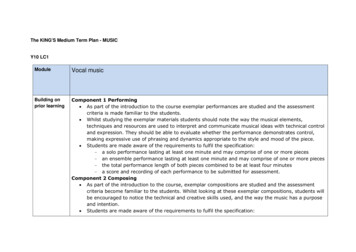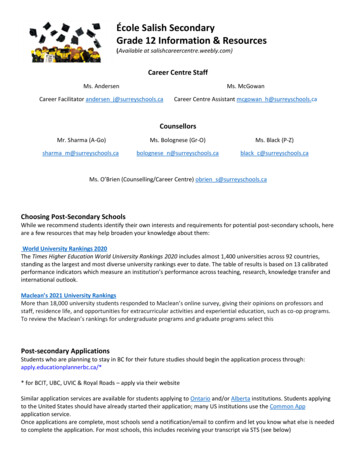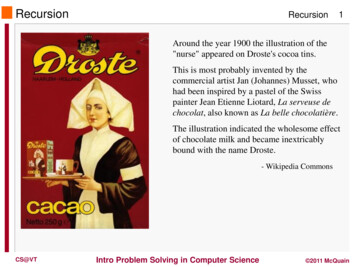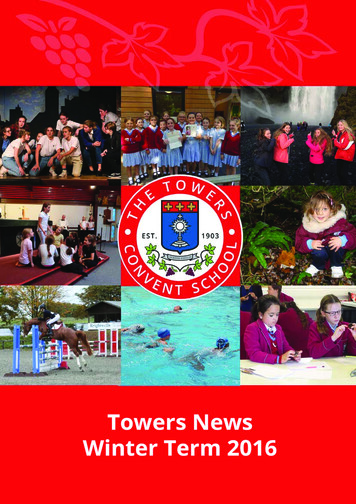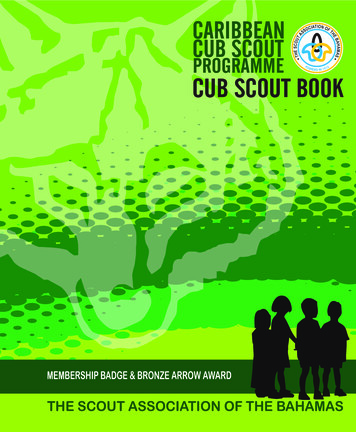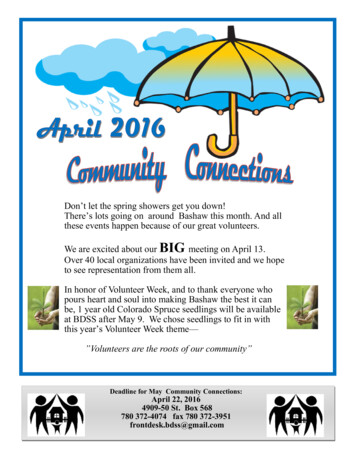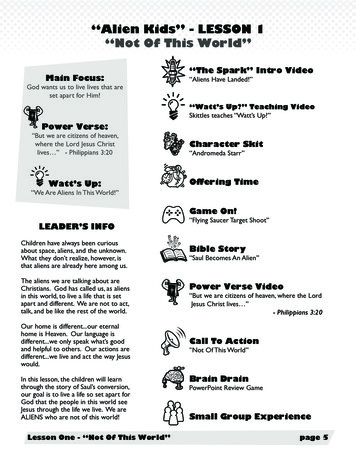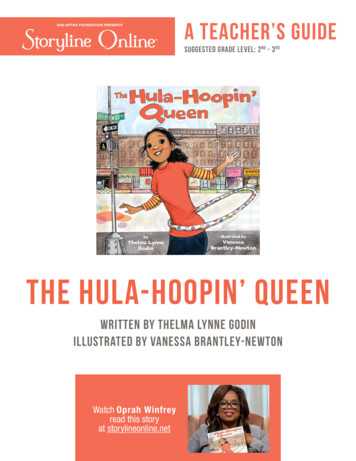
Transcription
a teacher’s guidesuggested grade level: 2 nd - 3 rdThe Hula-hoopin’ queenwritten by thelma lynne godinillustraTed by vanessa brantley-newtonWatch Oprah Winfreyread this storyat storylineonline.net
about this storySYNOPSISA spunky girl has a hula-hooping competition with her friends in Harlem, and soon everyone in theneighborhood—young and old alike—joins in on the fun.Kameeka is confident that today she will finally beat her rival, Jamara, and become the Hula-Hoopin’ Queen of139th Street. But then Mama reminds her that today is their neighbor Miz Adeline’s birthday, and Kameeka hasa ton of chores to do to get ready for the party they are hosting. Kameeka’s disappointed to be stuck at homeand can only think about the hoopin’ competition. Distracted, Kameeka accidentally ruins Miz Adeline’s birthdaycake, and has to confess to her that there won’t be a cake for her special day. But then Miz Adeline’s confessessomething too: she’s also got the itch—the hula-hoopin’ itch! Her fingers start snappin’. Her hips start swingin’.Soon everyone’s hips are swinging as the party spills out onto the street. The whole neighborhood’s got theitch—the hula-hoopin’ itch!With vibrant illustrations by Vanessa Brantley-Newton, The Hula-Hoopin’ Queen is a charming celebration offamily and community ties. Set in Harlem, this intergenerational story shows the importance of staying young atheart.THEMES IN THE STORYDreams and aspirations, Overcoming obstacles, Sharing and giving, Persistence, Holidays and traditionsPAGE 2 A teacher’s GUIDE the hula-hoopin’ queen 2019 SAG-AFTRA FOUNDATIONAbout This Guide: The purpose of this guide is to enhance the ELA curriculum by providing quality children’s literature to engagestudents in listening to expressive read alouds. Suggested story related activities are aligned with ELA Common Core Standards.
reading and writingSuggested grade level: 2 nd - 3 rdela common core standardReading Literature: Students read and respond to works of literature with emphasis on comprehension, makingconnections among ideas and between texts with focus on textural evidence. Standards listed below are for 2 nd and3 rd grades but can be adapted to 1 st grade standards.before viewingStandards:CCSS.SL.2.1, CCSS.SL.3.1Objective:Tap knowledge and build background to prepare for reading the story.Procedure: What does it mean to be “queen” of something? Ask students if they consider themselvesto be queen, or king, of something. Discuss. Discuss hula-hoops (Google It! for information on origin). Ask students if they haveever tried to hula-hoop? Have them demonstrate how it’s done. Introduce the title, The Hula-Hoopin’ Queen, and ask students to predict what the storywill be about.during viewingFocus:Problem - SolutionStandards:CCSS.SL.2.2, CCSS.SL.3.2Objective:Students will listen to identify the problem and tell how the problem was solved.Procedure:Step 1: Explain to students that every story has a problem. Ask students to listen for theproblem in the story.Step 2: Stop story at appropriate spots to ask questions to help students identify the problem.Step 3: After listening, have students discuss the problem and solution within small groups orwith a partner.Step 4: Gather the class for whole group discussion.PAGE 3 A teacher’s GUIDE the hula-hoopin’ queen 2019 SAG-AFTRA FOUNDATIONAbout This Guide: The purpose of this guide is to enhance the ELA curriculum by providing quality children’s literature to engagestudents in listening to expressive read alouds. Suggested story related activities are aligned with ELA Common Core Standards.
after viewing – Figurative languageStandards:CCSS.RL.2.4, CCSS.RL.3.4Objective:Students will identify figurative language and explain its meaning.Materials:Student worksheet (see page 8 for teacher examples and page 9 for student worksheet)Computers or tablets for student useProcedure:Step 1:Teach or review the types of figurative language with students.Step 2:Explain to students that they should listen to the story again to identify figurativelanguage found in the story.Step 3:Pass out the worksheet and go over directions.Step 4:Complete the worksheet.Step 5:Share responses and discuss literal versus non-literal meaning.reading responseStandards:CCSS.RL.2.1, CCSS.RL.3.1Objective:Students will answer the prompt using at least two details from text to support the response.Reading Prompt: Who is the “real Hula-Hoopin’ Queen of 139th Street”? Use details from the story to supportyour response.writingStandards:CCSS.W.2.3, CCSS.W.3.3Objective:Students will write a first-person narrative piece using grade appropriate sentence structure and spelling.Writing Prompt: Tell about a time when you tried to earn the title Queen (or King) of something.Materials:Writing toolsProcedure:Step 1:Review first-person point of view.Step 2:Explain to students that they will write a story from the first- person point of view – they will bethe main character in the story.Step 3:Generate a list of first-person words that students should use in their story.Step 4:Tell students that in the story the girls were competing very hard to be the Queen of HulaHoopin’. Ask students to think of a time they worked really hard to be good at something so thatthey could be called the Queen (or King) of Step 5:Show students the prompt and discuss.Step 6:Guide students through the Writing Process.Step 7:Display student work with a sign - Kings and Queens of .PAGE 4 A teacher’s GUIDE the hula-hoopin’ queen 2019 SAG-AFTRA FOUNDATIONAbout This Guide: The purpose of this guide is to enhance the ELA curriculum by providing quality children’s literature to engagestudents in listening to expressive read alouds. Suggested story related activities are aligned with ELA Common Core Standards.
across the curriculum activitiesscienceStudents will apply physics to hula-hoopin’.MATERIALS —2 Hula-hoops (per partners)Duct tapeYard stickTimer or stopwatchData recording sheet (see page 11)Teacher Prep: Make a class tally chart similar to the one below.Applying Physics to a Hula HoopScience Inquiry Question: Does the weight of a hula-hoop affect how it spins?Which do you think will spin better – a heavy hoop or a lighter one? Does it matter?QuestionTallyTotalA heavy hula-hoop will spin better.A light hula-hoop will spin better.It doesn’t matter – they will spin the same.PROCEDURE —Step 1:Provide background knowledge about physics, force, and friction.Step 2:Divide students into pairs and give each pair 2 hula-hoops.Step 3:Distribute a Data Recording Sheet to each pair.Step 4:Discuss the Science Inquiry Question. Ask each pair to make a prediction. Write the prediction in the spaceprovided on the worksheet.Step 5:Use the tally chart to record class predictions. Have students total the tally marks.Step 6:Instruct pairs to measure and cut 3 feet of duct tape. Duct tape one hula-hoop.Step 7:Explain the science procedure:1. Start with the lighter hoop. One partner will be the hula-hooper while the otherpartner starts timing the hula-hooper as soon as they reach a steady pace. Timethe hula-hooper for one minute and count how many full turns the hoop makesduring that time. (Time can be adjusted to 30 seconds)2. Record the data on the worksheet. Switch rolls and repeat.3. Repeat the process with the duct taped hula-hoop. (Make sure the hooperdoesn’t change shirts while collecting data)4. If time permits, allow students to repeat the process more than once. Are theresults consistent?Step 8:Complete the data sheet.Step 9:Discuss and analyze the results with the class.PAGE 5 A teacher’s GUIDE the hula-hoopin’ queen 2019 SAG-AFTRA FOUNDATIONAbout This Guide: The purpose of this guide is to enhance the ELA curriculum by providing quality children’s literature to engagestudents in listening to expressive read alouds. Suggested story related activities are aligned with ELA Common Core Standards.
MATH – GEOMETRY: CIRCLESStudents identify the circumference, diameter, and radius of a circle.MATERIALS —Circle outline (see Teacher Prep below)Yarn or string: 3 different colorsRulerScissorsGluePencilTeacher Prep: Draw an outline of a circle on paper (measure the circumference and include a center point).Make a copy for each studentPROCEDURE —Step 1:Instruct students to use a ruler to measure a piece of colored string that is equal to the circumference ofthe circle outline.Step 2:Have students place the string around the circle outline.Step 3:Introduce the term circumference. Tell students that this string represents the circumference of the circle.The circumference is the distance around the edge of the circle. Explain that the length of the string isequal to the circumference, because if you were to undo the circle, you would have the same length as thestring. Glue the string around the outline of the circle. Label the circumference with its measurement.Step 4:Introduce the term diameter. Diameter is the distance from one edge of the circle to the other. Tell studentsto take another color string and place it in the middle of the circle from one edge to the other, cutting offany extra string that extends over the border. Glue the string on the circle. Ask students to measure thepiece of string and write its measurement above. Explain that this straight piece of string going through thecenter of the circle is the diameter. Label the diameter.Step 5:Introduce the term radius. Explain that the radius is the distance from the center point to any point on thecircumference of the circle. Take the third color string. Instruct students to measure the string so that itis half the length of the diameter. Glue one end of the string to the center point of the circle. Explain thatthis piece of string represents the radius. The radius is one half of the diameter. Explain that the radius isthe same length from the center point to any point on the circumference. Have students move the radiusaround the circle. Glue the radius in place and label.Step 6:Have students write the definition of each term on the sheet.PAGE 6 A teacher’s GUIDE the hula-hoopin’ queen 2019 SAG-AFTRA FOUNDATIONAbout This Guide: The purpose of this guide is to enhance the ELA curriculum by providing quality children’s literature to engagestudents in listening to expressive read alouds. Suggested story related activities are aligned with ELA Common Core Standards.
ART – Kandinsky Circle ArtStudents learn about Wassily Kandinsky and his circular color studies.MATERIALS —Poster PaperMarkers or crayonsExamples of circular art by Kandinsky (Google It!)PROCEDURE —Step 1:Introduce students to the visual artist Wassily Kandinsky and point out that he was also a talented musician.Step 2:Show students an example of his circular color art.Step 3:Explain to students that color often relates to emotions: red- anger; blue- calmness or loneliness;yellow- happiness, contentment; green – harmony; black- sadness, etc.Step 4:Discuss Kandinsky’s works and how it makes them feel.Step 5:Have students fold the drawing paper into six squares.Step 6:Draw and color a different size circle in each square.Extend It: Play music while students are drawing and have them use the colors to represent how the musicmade them feel as they were drawing.physical education – Hula-Hoop RelayMATERIALS —1-4 Hula-hoopsPROCEDURE —Step 1:Divide students into two teams. Have each team form a straight line.Step 2:Explain the rules:- The hula-hoop must not touch the ground at any time- The circle of hands must not be brokenStep 3:Have each team join hands in a line.Step 4:Have the first person in line place the hula-hoop on her shoulder, then join hands with the lastperson in line to form a circle.Step 5:Have each person wriggle and squirm through the hoop to help move it around the circle until itmakes its way back to the beginning. Don’t let the circle break and remember the rules.Step 6:The winner is the first team to complete the circle.Step 7:You can add a second or third hula-hoop for more of a challengePAGE 7 A teacher’s GUIDE the hula-hoopin’ queen 2019 SAG-AFTRA FOUNDATIONAbout This Guide: The purpose of this guide is to enhance the ELA curriculum by providing quality children’s literature to engagestudents in listening to expressive read alouds. Suggested story related activities are aligned with ELA Common Core Standards.
The Hula-Hoopin’ QueenFigurative Language Examples (teacher use)SimileMama stands as still as water in a puddle .noddin’ her head like a spring robinlooking for a wormMy heart is racing as fast as the rollercoaster on Coney IslandThe candle glows as bright as the smile onMiz Adeline’s face.The streetlights shine like starsMetaphorTrucks throwing up heat and dust fromthe pavement.Mama is madder than a hornet.The sidewalk is cooler than a spring rain.IdiomsThe itch - The Hula-Hoopin’ itchShe gives me her look.I see Jamara hoopin’ on the cornerI was born readyHeat washes up over me and I stamp my foot.Onomatopoeiaring, snappin’, tappin’, swish, clatterHyperboleWe polish each window ‘til we can see clearto New Jersey.A grin greater than the Brooklyn Bridgestretches across my face.PAGE 8 A teacher’s GUIDE the hula-hoopin’ queen 2019 SAG-AFTRA FOUNDATIONAbout This Guide: The purpose of this guide is to enhance the ELA curriculum by providing quality children’s literature to engagestudents in listening to expressive read alouds. Suggested story related activities are aligned with ELA Common Core Standards.
Page 1 of 2Name:The Hula-Hoopin’ QueenFigurative Language WorksheetFigurative Language is when you use a word or phrase that does not have its normal everyday literalmeaning. Writers use figurative language to make their work more interesting. Some examples of figurativelanguage are:Simile – a figure of speech comparing two unlike things using like or as - Her hair was as soft as silk.Metaphor – states a fact or draws a veral picture by comparing two things - Her hair was silk.Idiom – an expression whose meaning is not understood from the usual meanings of the words used I am the hula hoopin’ queen!Hyperbole – big exaggeration, usually with humor - I’m so hungry I could eat a horse!Onomatopoeia – words that imitate sound - bing, bang, boomDirections: Listen to the story for figurative language. Write the example,what it really means, and the name of the figurative language in the chartbelow. An example is done for you.Figurative LanguageReal MeaningName of FigurativeLanguageHula hoopin’Someone who is the best hula hooper.IdiomPAGE 9 A teacher’s GUIDE the hula-hoopin’ queen 2019 SAG-AFTRA FOUNDATIONAbout This Guide: The purpose of this guide is to enhance the ELA curriculum by providing quality children’s literature to engagestudents in listening to expressive read alouds. Suggested story related activities are aligned with ELA Common Core Standards.
Page 2 of 2Figurative LanguageReal MeaningName of FigurativeLanguagePAGE 10 A teacher’s GUIDE the hula-hoopin’ queen 2019 SAG-AFTRA FOUNDATIONAbout This Guide: The purpose of this guide is to enhance the ELA curriculum by providing quality children’s literature to engagestudents in listening to expressive read alouds. Suggested story related activities are aligned with ELA Common Core Standards.
Names:Applying Physics to Hula-Hoopin’SCIENCE INQUIRY QUESTION: Does the weight of a Hula-Hoop affect how it spins?Discuss the question and circle your prediction:We think a heavy Hula-Hoop will spin better.We think a lighter Hula-Hoop will spin better.We don’t think weight matters.Gather Data:One partner is the Hula-Hooper and the other partner times and counts thenumber of spins. Record results. Switch rolls. Repeat process two more times.Hula-HoopPartner 1 - Number of SpinsTry 1Try 2Try 3Partner 2 - Number of SpinsTry 1Try 2Light WeightHeavy WeightUse the data to answer the questions:Which Hula-Hoop spun faster?Which one was easier to spin?Was the fastest Hula-Hoop also the one that was the easiest to spin, once it got going?Did both partners get the same results?Was your prediction correct?Explain what you learned about physics from this experiment.PAGE 11 A teacher’s GUIDE the hula-hoopin’ queen 2019 SAG-AFTRA FOUNDATIONAbout This Guide: The purpose of this guide is to enhance the ELA curriculum by providing quality children’s literature to engagestudents in listening to expressive read alouds. Suggested story related activities are aligned with ELA Common Core Standards.Try 3
about usabout storyline onlineThe SAG-AFTRA Foundation’s Emmy nominated children’s literacy program Storyline Online streamsimaginatively produced videos featuring celebrated actors to help inspire a love of reading. Storyline Online receives millions of views every month in hundreds of countries. Visit Storyline Online at storylineonline.net.about the sag-aftra foundationThe SAG-AFTRA Foundation provides vital assistance and educational programming to the professionals of SAG-AFTRAwhile serving the public at large through its signature children’s literacy program. Founded in 1985, the Foundationis a national non-profit organization that relies solely on support from grants, corporate sponsorships, and individualcontributions to fund our programs. Visit sagaftra.foundation.storyline online brought to you byPAGE 12 A teacher’s GUIDE the hula-hoopin’ queen 2019 SAG-AFTRA FOUNDATIONAbout This Guide: The purpose of this guide is to enhance the ELA curriculum by providing quality children’s literature to engagestudents in listening to expressive read alouds. Suggested story related activities are aligned with ELA Common Core Standards.
Tell students that in the story the girls were competing very hard to be the Queen of Hula-Hoopin’. Ask students to think of a time they worked really hard to be good at something so that they could be called the Queen (or King) of Show students the prompt

